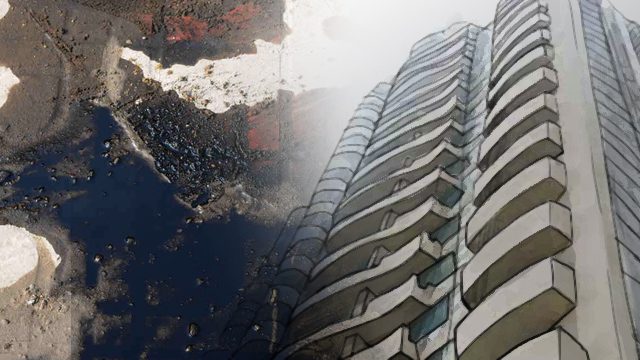SUMMARY
This is AI generated summarization, which may have errors. For context, always refer to the full article.

MANILA, Philippines – The Supreme Court (SC) said on Thursday, June 18, that it is allowing the reopening of the white oil pipeline (WOPL) being operated by the Lopez-owned First Philippine Industrial Corporation (FPIC) that leaked in 2010, provided that tests would show it is already safe for commercial use.
In a resolution issued June 16, the SC en banc adopted the 2012 report and recommendations issued by the Court of Appeals (CA) that heard the petition for the writ of kalikasan filed by West Tower Condominium operators, unit owners, and nearby residents in Barangay Bangkal, Makati City, who were forced to vacate their residences due to health and safety concerns.
SC enumerated several tests to be undertaken by the FPIC with the supervision of the Department of Energy (DOE) before it can resume operations. Among the tests that the SC directed FPIC to conduct include:
- Demonstrate and observe the various pressure and leakage tests;
- Monitor hourly the pressure rating after the pipeline is filled with dyed water and pressurized at a specified rate;
- Continue, inspect, and oversee the current gas monitoring system, or the monitoring of gas flow from the boreholes and monitoring wells of the WOPL
“In the event that the DOE is satisfied that the WOPL is safe for continued commercial operations, it shall issue an order allowing FPIC to resume the operations of the pipeline,” the SC ruled.
SC also directed the FPIC to undertake and continue the “remediation, rehabilitation, and restoration” of the affected Barangay Bangkal environment until it is restored to its condition prior to the leakage.
Once the WOPL is reopened, the High Court tasked the DOE to see to it that FPIC complies with measures to prevent similar incident in the future.
Among them is the continuous implementation of FPIC’s Pipeline Integrity Management System (PMS), which include (as reviewed by DOE):
- The conduct of daily patrols on the entire stretch of the WOPLE every two hours
- Continued close monitoring of all the boreholes and monitoring wells of the WOPL, pipeline
- Regular periodic testing and maintenance based on its PIMS
- The auditing of the pipeline’s mass input versus mass output
The SC also ordered FPIC to submit to DOE within 10 days of each succeeding month a compliance report.
The Court, however, begged off from ruling on the finding of the CA that the individual directors and officers of FIPC and First Gen Corporation (FGC) are not liable in their individual capacities for the leakage.
The court noted that it is clear in the rules of procedure for envrionmental cases that in a petition for a writ of kalikasan, the Court cannot grant the award of damages to individual petitioners.
FPIC said it will abide by the order.
‘Safest, most efficient’
In 2013, DOE asked CA to allow the reopening of the 117-kilometer Batangas to Manila WOPL after its leak test conducted indicated no more leaks in the pipeline.
The DOE recommended to allow FPIC to start its operation anew, pending the resolution of the residents’ petition.
DOE said the 43-year-old pipeline is still the “safest and most efficient” mode of transporting petroleum products despite of the leakage it experienced since “it poses lower risks to life and limb.”
The energy department added that the pipeline is more reliable than transporting the fuel products through lorry trucks as it is not affected by weather, traffic, and truck ban in Metro Manila.
FPIC said that it has been working closely with government agencies and has complied with government regulations “to ensure the pipeline’s integrity and the return to regular operations of an infrastructure that is vital to the Philippine economy and the lives of thousands of Metro Manilans.” – Rappler.com
Fuel leak concept image from Shuttertstock
Add a comment
How does this make you feel?
![[EDITORIAL] Apat na taon na lang Ginoong Marcos, ‘di na puwede ang papetiks-petiks](https://www.rappler.com/tachyon/2024/07/animated-bongbong-marcos-2024-sona-day-carousel.jpg?resize=257%2C257&crop=280px%2C0px%2C720px%2C720px)
![[In This Economy] Delulunomics: Kailan magiging upper-middle income country ang Pilipinas?](https://www.rappler.com/tachyon/2024/07/in-this-economy-upper-middle-income-country.jpg?resize=257%2C257&crop=421px%2C0px%2C1080px%2C1080px)

![[EDITORIAL] Marcos Year 2: Hilong-talilong](https://www.rappler.com/tachyon/2024/07/animated-bongbong-marcos-2nd-sona-carousel.jpg?resize=257%2C257&crop=136px%2C0px%2C720px%2C720px)
![[Newspoint] A fighting presence](https://www.rappler.com/tachyon/2024/07/thought-leaders-a-fighting-presence.jpg?resize=257%2C257&crop=441px%2C0px%2C1080px%2C1080px)
There are no comments yet. Add your comment to start the conversation.